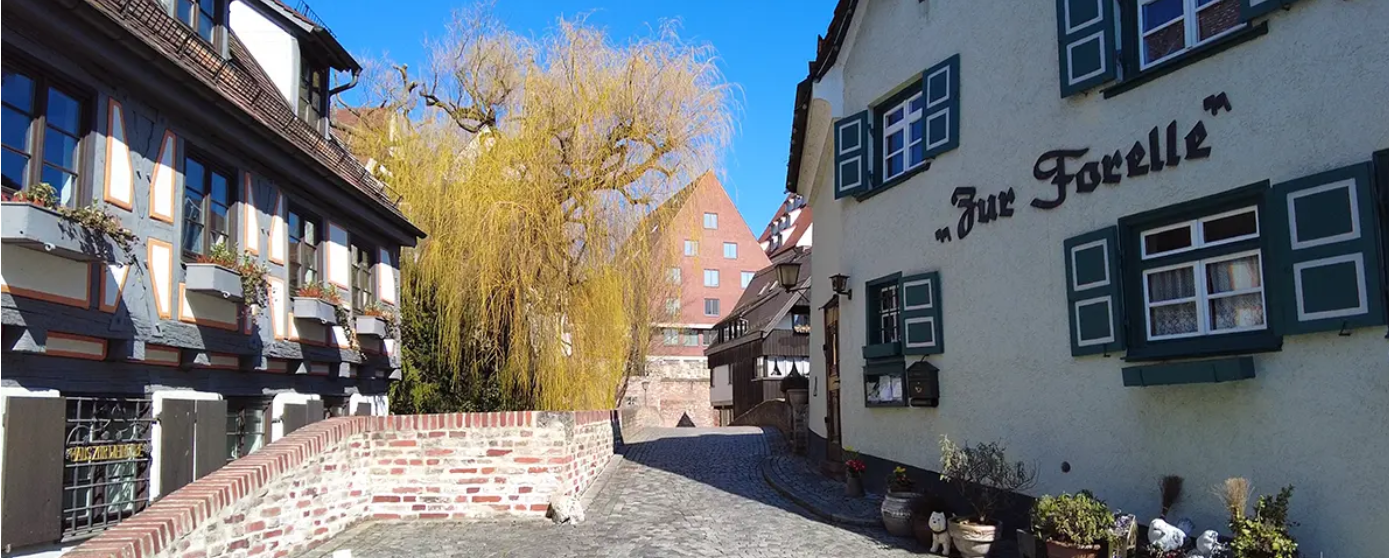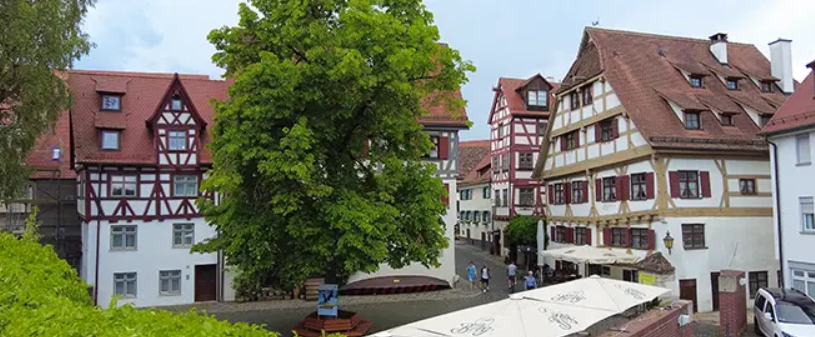Ulm’s medieval center with impressive half-timbered houses
Address: Ulm Fishermen’s and Tanners’ Quarter, Fischergasse, 89073 Ulm | Founded: 14th century
A tour through the Fishermen’s and Tanners’ Quarter is particularly enchanting due to the charming flair that this part of Ulm exudes. There are beautiful, ancient half-timbered houses, narrow alleys, and pretty squares that never cease to amaze visitors. The Blau River flows through the quarter, which was once of great importance for fishermen and tanners to practice their trades.
Today, the Fishermen’s and Tanners’ Quarter exudes a special charm. Each half-timbered house has its own unique story to tell, dating back to the 15th century.
Directions and Location of Ulm’s Landmark
The Fishermen’s and Tanners’ Quarter is framed by Ulm’s city wall toward the Danube. From there, Fischergasse runs along the quarter and forms the upper boundary. On the other side is Fischergasse, which further defines the core. Himmelgasse also borders this special quarter.
The landmark can be reached on foot from Ulm Central Station in about 10 minutes.
It is only a few minutes’ walk from Ulm Minster. The alleys in the Fishermen’s and Tanners’ Quarter are paved with coarse cobblestones, so flat shoes are best worn when walking. This is also important for people with walking difficulties or wheelchair users to decide whether a visit to the quarter is feasible.
Opening Hours and Tours
The charming half-timbered houses can be visited at any time, as the Fishermen’s and Tanners’ Quarter is a public area with no opening hours. Strolling through the winding alleys, you’ll come across galleries, small shops selling select products, and specialty stores. Numerous cafés and restaurants have also settled in the Fishermen’s and Tanners’ Quarter. Relaxing and celebrating is possible in several pubs.
Both the galleries, shops, and restaurants have opening hours. Those who want to enjoy Swabian cuisine or delicious fish must adhere to the opening hours. Browsing in shops and galleries is also only possible during store hours.

Entrance Fees for the Fishermen’s and Tanners’ Quarter
There’s no need to pay for entrance fees to visit the idyllic Fishermen’s and Tanners’ Quarter at the confluence of the Danube and Blau rivers, as the quarter is open to the public.
FAQ – Frequently Asked Questions about the Fishermen’s Quarter in Ulm
How old is the Fishermen’s Quarter in Ulm?
Ulm’s Fishermen’s Quarter is over 500 years old and is one of the oldest districts in Ulm. It was established in the 14th century and is characterized by narrow streets, historic half-timbered houses, and picturesque canals. The Fishermen’s Quarter once served as a central hub for Ulm’s fishing industry, where fishermen played a significant role.
What is the significance of Ulm’s Fishermen’s and Tanners’ Quarter?
Ulm’s Fishermen’s and Tanners’ Quarter has historically been of great importance to the city. It was a central location for the fishing and tanning industries, making it an economic hub. The fishermen and tanners formed important groups in urban society, with their own administrative structures and jurisdictions. Today, the quarter is a cultural and tourist center of historical significance, attracting visitors with its picturesque alleys and well-preserved medieval architecture.
Fishermen’s and Tanners’ Quarter – Special Features and Interesting Facts
The Blau River flows through the Fishermen’s and Tanners’ Quarter with two branches that later flow into the Danube. Numerous half-timbered houses were built along its banks between the 15th and 17th centuries. Some of their foundations are submerged in water. This created a soft subsoil that gave way. As a result, some houses have sunk toward the water over the years, giving this picturesque quarter a special charm.
The Fishermen’s and Tanners’ Quarter, through which the Blau River flows, was the area in Ulm where Danube fishermen, boatmen, and tanners still lived in the 19th century. Because the tanners processed their animal hides there, a terrible stench prevailed in some places. For the artisans who settled in the Fishermen’s and Tanners’ Quarter, the Blau River provided a livelihood.
Today’s charming houses served as both living and working spaces. The people who lived and worked there were a stubborn bunch, characterized by hard work, and were called “Räsen” (Raws).
In the 19th century, traditional crafts disappeared from the fishing and tanning district, and small businesses took over. Since little money was being earned, the buildings could not be maintained, which naturally worsened their condition. Even before the war, parts of the district were threatened with decay, and after the war, nothing changed.
This also ensured that the fishing and tanning district remained in a miserable state. No one felt responsible for it. This was indeed a stroke of luck. This prevented the district from being razed to the ground.
The fishing and tanning district was brought back to life in the 1970s. Because a private citizen invested money to save and renovate the historic Lochmühle mill and several other buildings, the district slowly began to revive. Other Ulm residents followed his example, invested money, and made the fishing and tanning district what it is today – an idyllic place with a very special charm!

Historical Facts and History of the Fishermen’s and Tanners’ Quarter
As the name suggests, the Fishermen’s and Tanners’ Quarter provided a livelihood for fishermen, boatmen, and tanners who settled there as early as the Middle Ages. Fishermen and boatmen could quickly and easily reach the Danube in small boats to pursue their trade. Fishermen brought fresh fish from the Danube daily to sell at the market.
Shipbuilding later became an important economic sector. Flat, wooden boats with a box-like structure were built there. Due to their unusual shape, they were called “Ulm boxes.” These special wooden boats transported both goods and people downstream on the Danube.
Although the Fishermen’s Quarter is almost always referred to as the Fishermen’s and Tanners’ Quarter, the correct name for this district is “Fishermen’s and Tanners’ Quarter.” Because of the Blau River, which flows through the district, it was also of interest to tanners. Their distinctive houses provide an impressive demonstration of how leather was produced and processed.
Balconies or galleries stand on wooden stilts in the waters of the Blau. This is where the animal hides were processed and drained for further processing. In addition, a total of seven mill wheels were kept running by the Blau.
The former life in the fishing and tanning district bears little resemblance to the romantic atmosphere that the area exudes today. The animal hides, in particular, gave the narrow alleys a rotten, disgusting stench.
Today, the fishing and tanning district offers a special atmosphere with a delicious meal or a delicious coffee. For centuries, the people of the fishing and tanning district have known the importance of good food and delicious drinks.

Sights and attractions in the immediate vicinity of the Fishermen’s and Tanners’ Quarter
Fans of unique architecture will find their money’s worth in the Fishermen’s and Tanners’ Quarter. Old and new Ulm blend together in a distinctive way nearby. Not far from monumental buildings, ultramodern architecture can be found when taking a walk from the Fishermen’s and Tanners’ Quarter to Neue Straße.
The white Town Hall and the glass pyramid that houses the City Library are striking.
Not far from the Fishermen’s and Tanners’ Quarter are the Danube Meadows. After a stroll, you can linger there in fine weather and enjoy the magnificent view of the other side of the Danube.
Just a minute’s walk from the Fishermen’s and Tanners’ Quarter is the Schwörhaus (Oath House), also a historical landmark.
Visitors to Ulm and the Fishermen’s and Tanners’ Quarter will also encounter the Ulm Sparrow in many places, colorfully and cheerfully perched on a building, in a square, or on a pole in the blue sky. This special symbol of Ulm can also be found on rooftops.
Cafes and Restaurants Near the Fishermen’s and Tanners’ Quarter
For delicious dishes and delicious coffee specialties, you don’t have to leave the Fishermen’s and Tanners’ Quarter. There are charming cafés and restaurants there that invite you to enjoy and linger.
The Gasthaus zur Forelle (Forest Inn) is located in the former fishermen’s guild house on Fischergasse. In addition to Swabian specialties, it also offers a wide selection of other dishes and, of course, deliciously prepared fish. Even the tailor of Ulm and Albert Einstein dined there in a cozy atmosphere.
Address: Gasthaus zur Forelle, Fischergasse 25
The First Ulm Pancake House – Allgäuer Hof on Fischergasse is known far beyond the city limits. For over 100 years, delicious pancakes in all imaginable variations have been lovingly served here. There’s sure to be just the right pancake for everyone. After the pancake, round off the experience with a coffee.
Address: Allgäuer Hof – First Ulm Pancake House, Fischergasse 12
Cafe Ulmer Münz
This restaurant is located in a 16th-century building in Ulm’s Old Town, directly opposite the Hotel Schiefes Haus. The outdoor area is especially inviting. In addition to a selection of hot and cold drinks and various cakes, guests can also enjoy dumplings, stew, or beef roulade.
Address: Cafe Ulmer Münz, Schwörhausgasse 4/1
At the Zur Lochmühle restaurant in the fishermen’s and tanners’ quarter on Gerbergasse, guests are treated to Swabian specialties in the cozy restaurant. There is a lovely outdoor terrace where, in warm weather, you can enjoy great dishes, delicious beer, and other drinks with a view of the old mill wheel.
Address: Zur Lochmühle, Gerbergasse 6
Gerberhaus
Located in the heart of the fishing and tanning district, the Gerberhaus on Weinhofberg spoils guests with Swabian specialties. Other delicacies such as salads, German dishes, and desserts are also served in a tasteful, rustic setting. The menu also includes coffee specialties, fine wines, beer, and non-alcoholic beverages.
Address: Gerberhaus, Weinhofberg 9